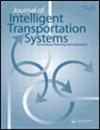Real-time anomaly detection of short-term traffic disruptions in urban areas through adaptive isolation forest
IF 2.8
3区 工程技术
Q3 TRANSPORTATION
Journal of Intelligent Transportation Systems
Pub Date : 2025-05-04
DOI:10.1080/15472450.2024.2312809
引用次数: 0
Abstract
The escalating congestion impacts of short-term traffic disruptions, such as double parking or short-duration work zones, are gaining increased attention. This study introduces an enhanced isolation forest-based unsupervised anomaly detection algorithm to detect short-term traffic disruptions in urban areas. To enable the detection in real-time, a sliding window approach is introduced to allow the streaming data to be read and processed according to the window size. An adaptive threshold that automatically adjusts itself to overcome the limitations of the miss rate on local anomalies is shown to further enhance the model predictions. The proposed algorithm is empirically validated on four study sites in Manhattan, New York City. The experimental results demonstrate that the proposed unsupervised algorithm can effectively detect different types of traffic anomalies including accidents, work zones/road closures, traffic jams, double parking events and police activities. On all sites, the average detection rate is 81.1% for traffic jams and 89.6% for police activities, respectively. For three out of the four sites, the detection rate ranges from 71.4% to 100% for accidents, work zones and double parking. An optimizer using high-pass filter is also presented to further improve off-line detection. The primary advantages of this proposed computationally-efficient method are that its only required data input is travel time information and that it does not need labeled data for training, which make it highly deployable for real-time operational applications and can be easily adopted by other cities.
通过自适应隔离林实时检测城市地区短期交通中断的异常情况
短期交通中断(如双倍停车或短时工作区)对交通拥堵造成的影响日益严重,正受到越来越多的关注。本研究引入了一种增强型隔离系统,它能在短时间内对交通拥堵造成的影响进行分析。
本文章由计算机程序翻译,如有差异,请以英文原文为准。
求助全文
约1分钟内获得全文
求助全文
来源期刊
CiteScore
8.80
自引率
19.40%
发文量
51
审稿时长
15 months
期刊介绍:
The Journal of Intelligent Transportation Systems is devoted to scholarly research on the development, planning, management, operation and evaluation of intelligent transportation systems. Intelligent transportation systems are innovative solutions that address contemporary transportation problems. They are characterized by information, dynamic feedback and automation that allow people and goods to move efficiently. They encompass the full scope of information technologies used in transportation, including control, computation and communication, as well as the algorithms, databases, models and human interfaces. The emergence of these technologies as a new pathway for transportation is relatively new.
The Journal of Intelligent Transportation Systems is especially interested in research that leads to improved planning and operation of the transportation system through the application of new technologies. The journal is particularly interested in research that adds to the scientific understanding of the impacts that intelligent transportation systems can have on accessibility, congestion, pollution, safety, security, noise, and energy and resource consumption.
The journal is inter-disciplinary, and accepts work from fields of engineering, economics, planning, policy, business and management, as well as any other disciplines that contribute to the scientific understanding of intelligent transportation systems. The journal is also multi-modal, and accepts work on intelligent transportation for all forms of ground, air and water transportation. Example topics include the role of information systems in transportation, traffic flow and control, vehicle control, routing and scheduling, traveler response to dynamic information, planning for ITS innovations, evaluations of ITS field operational tests, ITS deployment experiences, automated highway systems, vehicle control systems, diffusion of ITS, and tools/software for analysis of ITS.

 求助内容:
求助内容: 应助结果提醒方式:
应助结果提醒方式:


